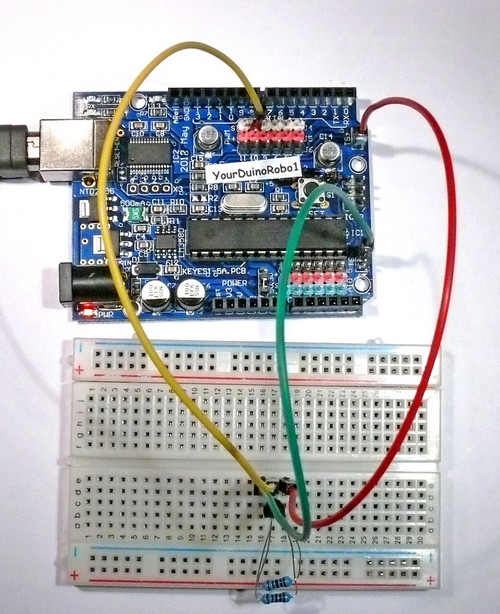YourDuinoStarter TemperatureSensor
YourDuinoStarter Example: TemperatureSensor
This example uses the DS18B20 Electronic Thermometer in the Starter Kit.
Photo on right shows how we connected it with the breadboard.
- Communicates with a DS18B20 temperature sensor, shows value read.
CONNECTIONS: (Holding chip with pins down, label towards you):
- Left pin: Ground
- Right pin: +5V
- Center pin: Arduino Pin 10 and ALSO "Pullup Resistor":
- Center pin: to 4700 (4.7K) or 5K resistor * (other end goes to +5V)
NOTE: Two 10K resistors connected in parallel can be used.
To make this work, you MUST download and install the library for DallasTemperature chips:
Then you need to copy it to your Arduino software installation Library folder. (this is called a "Library" not a Book! ) For more about Libraries see our Arduino Libraries page.
Questions: terry@yourduino.com
The output on the Serial Monitor should look like this: 
(Copy the text in the box below and Paste it into a blank Arduino IDE window)
/* YourDuinoStarter Example: Temperature Sensor - Communicates with a DS18B20 temperature sensor, shows value read. - SEE the comments after "//" on each line below - CONNECTIONS: (Holding chip with pins down, label towards you) - Left pin: Ground - Right pin: +5V - Center pin: Arduino Pin 10 and ALSO "Pullup Resistor": - Center pin: to 4700 (4.7K) or 5K resistor * (other end goes to +5V) * NOTE: Two 10K resistors connected in parallel can be used. - V1.04 02/11/13 Questions: terry@yourduino.com */ /*-----( Import needed libraries )-----*/ #include <OneWire.h> // For many "1-wire" devices #include <DallasTemperature.h> // Specific for temperature sensors /*-----( Declare Constants and Pin Numbers )-----*/ // Data wire is plugged into port 10 on the Arduino (can be changed) #define ONE_WIRE_BUS 10 // NOTE: No ";" on #define /*-----( Declare objects )-----*/ // Setup a oneWire instance to communicate with any OneWire devices // (not just Maxim/Dallas temperature ICs) OneWire oneWire(ONE_WIRE_BUS); // Pass address of our oneWire instance to Dallas Temperature. DallasTemperature sensors(&oneWire); /*-----( Declare Variables )-----*/ float TempInC ; //Floating Point variable for C Temperature float TempInF ; //Floating Point variable for F Temperature void setup() /****** SETUP: RUNS ONCE ******/ { Serial.begin(9600); // start serial port Serial.println("YourDuinoStarter Example: DS18B20 Temperature Sensor Reading"); sensors.begin(); // Start up the temperature measurement library }//--(end setup )--- void loop() /****** LOOP: RUNS CONSTANTLY ******/ { Serial.print("Requesting temperatures using Library ..."); sensors.requestTemperatures(); // Send the command to get temperatures Serial.println("DONE"); /*----( Here we will save values to use for other things)------*/ TempInC = sensors.getTempCByIndex(0); // Get and save sensor value TempInF = sensors.getTempFByIndex(0); // Get and save sensor value Serial.println("Here are our saved values"); Serial.print("Temperature in C = "); Serial.println(TempInC, 2); // "2" sets the number of decimal places Serial.print("Temperature in F = "); Serial.println(TempInF, 2); // "2" sets the number of decimal places Serial.println(); delay(5000); }//--(end main loop )--- /*-----( Declare User-written Functions )-----*/ //none //*********( THE END )***********
